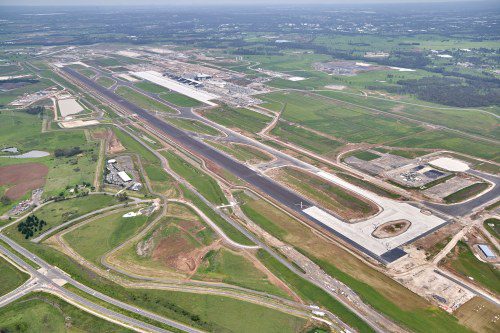 Western Sydney International (Nancy-Bird Wilton) Airport (WSI) has reached a monumental stage in its construction as the final layer of asphalt was meticulously laid onto the airport’s expansive 3.7km runway. This achievement marks a significant step forward for the ambitious project to revolutionize air travel in the region.
Western Sydney International (Nancy-Bird Wilton) Airport (WSI) has reached a monumental stage in its construction as the final layer of asphalt was meticulously laid onto the airport’s expansive 3.7km runway. This achievement marks a significant step forward for the ambitious project to revolutionize air travel in the region.
The laying of this last layer of asphalt is a testament to the unwavering commitment and determination of the teams involved in bringing WSI to life. While the core construction of the runway has now concluded, the forthcoming tasks include line marking and the final installation of 3,000 runway lights, which are slated for completion later in the year.
Simon Hickey, the CEO of WSI, expressed his satisfaction with this pivotal development, emphasizing its importance in the airport’s progress. “Nothing says ‘airport’ more than a runway, so we’re immensely proud to reach this crucial milestone in the realization of Sydney’s new airport,” said Hickey. An astonishing 55,000 tonnes of asphalt have been laid in this endeavour—enough to cover a staggering 41 soccer fields.
Hickey further elaborated on the significance of this achievement, highlighting the airport’s strategic design. “Our runway’s smart terminal design is poised to offer rapid taxi times of just 5 minutes from both ends of the runway, ensuring our customers reach the air or their gates swiftly.”
Upon its opening, WSI is set to deliver a remarkable addition to Sydney’s aviation landscape, providing an extra 20 flights per hour for the city. This increased capacity will offer Sydneysiders a more comprehensive array of choices and apply downward pressure on airfares, enhancing accessibility for all. Additionally, WSI aims to establish itself as the East Coast’s airport with the quickest minimum connection times, streamlining the transfer process for passengers with international and domestic flights under one roof.
Christian Byrne, the Project Director for the runway construction contractor CPB Contractors ACCIONA Joint Venture, commended the relentless effort put into the project. Over the course of three months, the team worked tirelessly, placing an astonishing 270 tonnes of asphalt per hour, all sourced from the on-site Boral batch plant.
Simultaneously, the team laid approximately 220km of aeronautical ground lighting cabling beneath the runway, equivalent to the distance between Sydney and Forster. The asphalt layers were meticulously laid in multiple passes and subjected to rigorous quality checks to meet stringent tolerances. Specifically designed asphalt mixes, capable of withstanding the repeated stress of aircraft take-offs and landings, have been utilized for the runway, offering superior flexibility and load-bearing capacity compared to standard road materials.
CEO Simon Hickey added that WSI’s design anticipates robust growth, positioning it to become Sydney’s largest airport. “We are on track to serve 82 million annual passengers, rivaling the world’s major airports like Dubai and London Heathrow. We’re set for a WSI opening in late 2026, making it less than three years until planes take off and land on the runway, connecting Sydney to the world through its cultural heartland in Western Sydney.”
In a landmark achievement, the Western Sydney International Airport is gradually becoming a reality, promising enhanced connectivity, convenience, and opportunities for travellers and the region. With its strategic design and relentless construction efforts, it is poised to reshape the future of aviation in Sydney and beyond.
Written by: Don Power
====================================



















